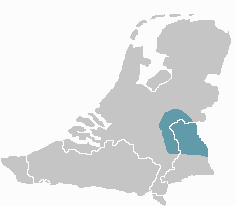Kleverlandish (Dutch: Kleverlands; German: Kleverländisch) is a group of Low Franconian dialects spoken on both sides of the Dutch-German border along the Meuse and Rhine rivers.
| Kleverlandish | |
|---|---|
| Native to | Germany, Netherlands |
Indo-European
| |
| Language codes | |
| ISO 639-3 | – |
| Glottolog | klev1234 |
 Kleverlandish dialect area (the southern extent in this map follows the Uerdingen line). | |
Extent and terminology
Kleverlandish varieties are spoken in the Netherlands in the northernmost part of Dutch Limburg, in the northeasternmost part of North Brabant (Land van Cuijk), and in the southeastern part of Gelderland (around Nijmegen), and in Germany in the districts of Cleves and Wesel in northwestern North Rhine-Westphalia. To the northeast, Kleverlandish borders on the Low Saxon speech area, its western border is the diphthongisation line.[1] Traditionally, its southern extent bordering on the South Low Franconian dialect group (commonly called "Limburgish" in Belgium and the Netherlands) is defined by the Uerdingen line (the ik-ich-isogloss),[1] but many Dutch and German scholars place the boundary further to the north based on wider criteria than the ik-ich-isogloss.[2][3][a]
Originally, the term Kleverländisch[b] referred only to the dialects in the German part of the speech area,[4] which are also called Niederrheinsch ('Low Rhenish') in traditional German dialectology.[c] The dialects on the Dutch side were first classified as a distinct group by te Winkel (1898) (as "Saxon-East Franconian") and Van Ginneken (1917) ("Guelderish-Limburgish"). The close affinity between these dialect areas had long been recognized by Dutch and German scholars;[d] but it was the Belgian dialectologist Jan Goossens who first extended the scope of the term "Kleverlandish" to include all varieties on both sides of the border.[5][4]
Characteristics
Kleverlandish is characterized by several conservative features, such as the retention of -al-/-ol- before consonants (e.g. Kleverlandish ald 'old'; in most Low Franconian dialects, -l- is vocalized in this environment (Limburgish aod, Standard Dutch oud), while Low Saxon dialects retains the -l- but merge the vowels to -o- (Low Saxon old)) or the retention of historically long high vowels (diphthongized in most Low Franconian dialects to the west, e.g. Kleverlandish is vs. Standard Dutch ijs < *īs).[6] A typical West Low Franconian feature is the fronting of /uː/ to /yː/ (e.g. hüs 'house' < *hūs) which however did not fully radiate into the German area of Kleverlandish, where in many areas it affects only part of the vocabulary.[7]
Status
In much of the Kleverlandish speech area in both the Netherlands and Germany, speakers are shifting from Kleverlandish to regional colloquial forms of the respective national languages, Dutch and German, with a higher degree of decline of dialect usage in Germany than in the Netherlands.[8] In Dutch Limburg, Kleverlandish varieties spoken within the province are included in the official recognition of Limburgish as a regional language (even though they do not belong to Limburgish in a dialectological sense). Official recognition does not extend to other Dutch provinces, nor to Germany.[e]
Other classifications
In the widely reproduced dialect map by Jo Daan, Kleverlandish dialects in the Netherlands are included in the large central-southern dialect group, but divided over two subgroups: varieties in Gelderland are assigned to the South Guelderish subgroup (which also includes dialects spoken in the southwest of Gelderland which have taken part in the Hollandic-Brabantian diphthongisation), while Kleverlandish varieties in North Brabant and Limburg are included in the North Brabant–North Limburg subgroup.[9]
In Heeringa (2004), Kleverlandish dialects in the Netherlands are assigned to two different major dialects groups: the Gelderland varieties are included in the Central Dutch group, while varieties in the Land van Cuijk and northern Limburg are included in the Limburg group.[10]
Notes
Citations
References
- Berns, Jan (1990). "Das Kleverland als Problemgebiet". In Grosse, Rudolf (ed.). Sprache in der Sozialen und Kulturellen Entwicklung: Beiträge eines Kolloquiums zu Ehren von Theodor Frings (1886–1968). Berlin: Akademie-Verlag. pp. 78–84. doi:10.1515/9783112532881-009.
- Bakker, Frens; van Hout, Roeland (2017). "De indeling van de dialecten in Noord-Limburg en het aangrenzende Duitse gebied. Hoe relevant is de Uerdingerlijn als scheidslijn?". Nederlandse Taalkunde. 22 (3): 303–332. doi:10.5117/NEDTAA2017.3.BAKK.
- Daan, Jo (1969). Van Randstad tot Landrand. Bijdragen en Mededelingen der Dialectcommissie van de KNAW XXXVI. Amsterdam: Noord-Hollandsche Uitgevers Maatschappij.
- De Vriend, Folkert; Giesbers, Charlotte; van Hout, Roeland; ten Bosch, Louis (2008). "The Dutch-German Border: Relating Linguistic, Geographic and Social Distances". International Journal of Humanities and Arts Computing. 2 (1–2). Edinburgh University Press: 119–134. doi:10.3366/E1753854809000342.
- Giesbers, Charlotte (2008). Dialecten op de grens van twee talen. Een dialectologisch en sociolingüistisch onderzoek in het Kleverlands dialectgebied (PhD thesis). Radboud Universiteit Nijmegen.
- Heeringa, Wilbert Jan (2004). Measuring Dialect Pronunciation Differences using Levenshtein Distance (PhD thesis). University of Groningen.
- Weijnen, A. (1958). Nederlandse dialectkunde. Assen: Van Gorcum & Comp.
- Wiesinger, Peter (1970a). Phonetisch-phonologische Untersuchungen zur Vokalentwicklung in den deutschen Dialekten, Band 1: Die Langvokale im Hochdeutschen. Berlin: Walter de Gruyter & Co.
- Wiesinger, Peter (1970b). Phonetisch-phonologische Untersuchungen zur Vokalentwicklung in den deutschen Dialekten, Band 2: Die Diphthonge im Hochdeutschen. Berlin: Walter de Gruyter & Co.
- Wiesinger, Peter (2017). "Strukturgeographische und strukturhistorische Untersuchungen zur Stellung der bergischen Mundarten zwischen Ripuarisch, Niederfränkisch und Westfälisch". In Peter Wiesinger; Franz Patocka (eds.). Strukturelle historische Dialektologie des Deutschen: Strukturhistorische und strukturgeographische Studien zur Vokalentwicklung deutscher Dialekte. Hildesheim / Zürich / New York: Georg Olms Verlag. pp. 341–437. hdl:20.500.12657/60904.
- Swanenberg, Jos (2019). "Grenzen aan de streektaal: De taalkundige en de culturele benadering van het Brabants in Nederland". In Veronique De Tier; Anne-Sophie Ghyselen; Ton van de Wijngaard (eds.). De wondere wereld van de streektaalgrenzen. Leiden: Stichting Nederlandse Dialecten. pp. 39–48.